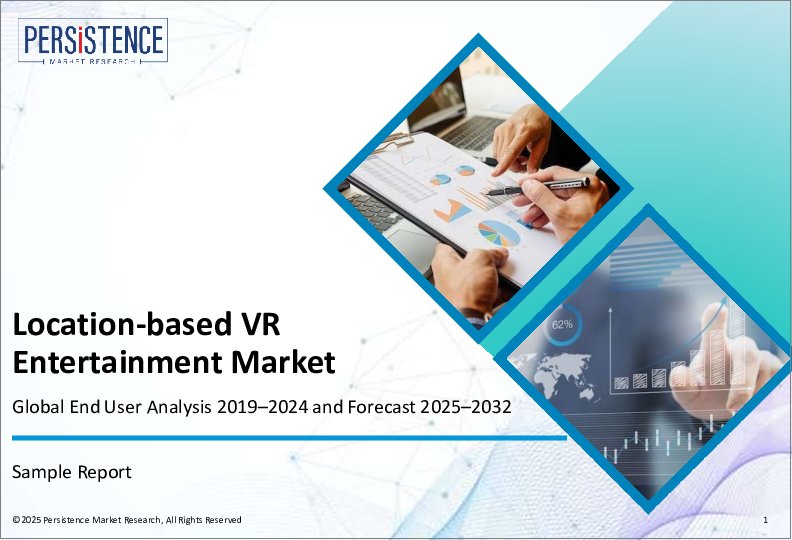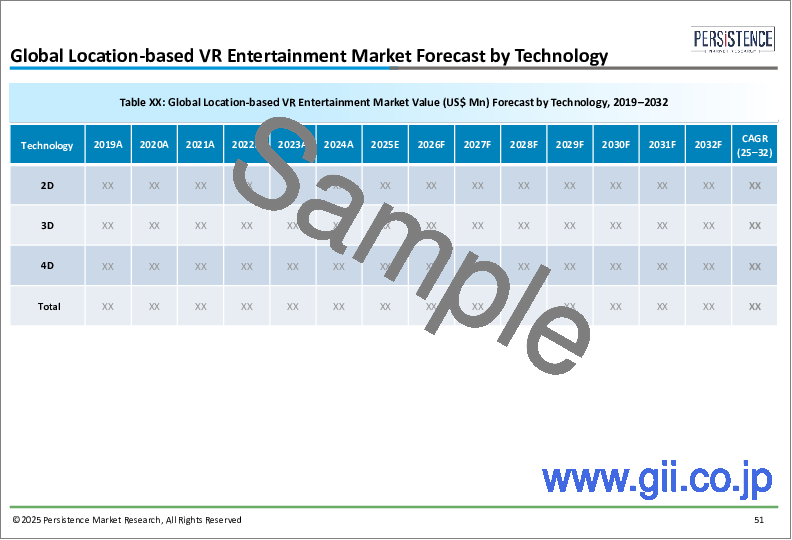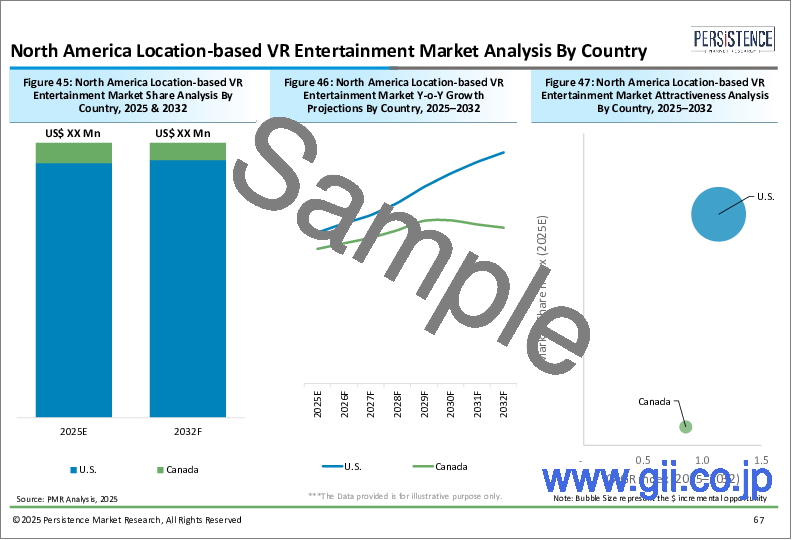|
|
市場調査レポート
商品コード
1672027
ロケーションベースVRエンターテインメント(LBE)の世界市場:産業分析、規模、シェア、成長、動向、予測(2025年~2032年)Location-based VR Entertainment (LBE) Market: Global Industry Analysis, Size, Share, Growth, Trends, and Forecast, 2025 - 2032 |
||||||
カスタマイズ可能
|
|||||||
| ロケーションベースVRエンターテインメント(LBE)の世界市場:産業分析、規模、シェア、成長、動向、予測(2025年~2032年) |
|
出版日: 2025年03月03日
発行: Persistence Market Research
ページ情報: 英文 250 Pages
納期: 2~5営業日
|
- 全表示
- 概要
- 目次
重要考察
- ロケーションベースVRエンターテインメント(LBE)の市場規模:39億7,120万米ドル(2025年)
- 予測される市場金額:204億7,160万米ドル(2032年)
- 世界市場の成長率:26.4%(2025年~2032年のCAGR)
ロケーションベースVRエンターテインメント(LBE)市場 - レポート範囲
ロケーションベースVRエンターテインメント(LBE)市場には、アミューズメントパーク、VRアーケード、テーマパーク、フィルム館などの専用会場で提供される没入型バーチャルリアリティ体験が含まれます。これらの体験は、先進のVRヘッドセット、モーショントラッキング技術、触覚フィードバックシステムを通じて、高品質でインタラクティブ、かつ社会的なエンゲージメントを提供するように調整されています。市場は、エンターテインメントを求める人々、ゲーマー、魅力的な体験の提供を目指す企業を対象としています。没入型エンターテインメントに対する消費者の関心の高まり、VRハードウェアとソフトウェアの技術的進歩、屋外エンターテインメント施設の拡大が成長の促進要因となっています。
市場成長の促進要因
世界のロケーションベースVRエンターテインメント(LBE)市場の主な促進要因は複数あります。没入型でインタラクティブなエンターテインメントソリューションに対する消費者の需要の高まりが、市場の拡大に大きく寄与しています。高忠実度VRヘッドセット、5G接続、AI駆動型コンテンツなどの技術の進歩は、全体的なユーザーエクスペリエンスを向上させ、LBEをより魅力的なものにしています。テーマパーク、ショッピングモール、VR専用アーケードなどの娯楽施設によるVRインフラへの投資の増加は、産業の成長を支えています。さらに、企業研修、観光、教育でのVR採用の増加は、エンターテインメント以外へと市場の範囲を広げています。
市場抑制要因
有望な成長見通しにもかかわらず、ロケーションベースVRエンターテインメント(LBE)市場は、セットアップやメンテナンスの高いコストという課題に直面しています。精巧なハードウェア、頻繁なソフトウェアアップデート、広い会場スペースが必要なため、業者には経済的負担がかかります。さらに、VRによる乗り物酔いや、VR装置を共有する際の衛生上の問題に対する懸念が、潜在的な利用者を遠ざける可能性があります。また、従来のエンターテインメントと比較してVR体験のチケットの価格が比較的高いことも、市場に対する浸透に影響を与える可能性があります。これらの課題に対処するには、費用対効果の高いソリューションへの継続的な投資、VRのエルゴノミクスの改良、ユーザーの快適性機能の強化が必要です。
市場機会
市場は、AI、ブロックチェーン、クラウドゲーミングなどの新技術の統合によって大きな機会をもたらしています。超リアルな多人数参加型VR体験やeスポーツイベントの拡大は、LBE業者に新たな収益源を生み出します。観光や遺産再現に向けたロケーションベースVRの開発は、文化的・教育的用途の可能性を提供します。さらに、VRコンテンツ開発者と大手エンターテインメントブランドとのパートナーシップは、LBE体験の魅力を高めることができます。ワイヤレスVRソリューションやコンパクトなモーションプラットフォームなど、持続可能でモジュール化されたVRセットアップへの選好の高まりは、この部門の技術革新をさらに促進します。
当レポートでは、世界のロケーションベースVRエンターテインメント(LBE)市場について調査分析し、成長促進要因、動向、機会、課題などの市場力学の詳細な分析を提供しています。
目次
第1章 エグゼクティブサマリー
第2章 市場の概要
- 市場の範囲/分類
- 市場の定義/範囲/制限
第3章 主な市場動向
- 市場に影響を与える主要動向
- 製品のイノベーション/開発の動向
第4章 価格分析
- 価格分析:製品別
- ハードウェア価格分析
- ソフトウェア価格分析
- 平均価格分析ベンチマーク
第5章 世界のロケーションベースVRエンターテインメント(LBE)市場の見通し(2019年~2032年)
- 市場金額の実績の分析(2019年~2024年)
- 現在と将来の市場金額の予測(2025年~2032年)
- 前年比成長動向の分析
- 絶対的収益機会の分析
第6章 市場の背景
- マクロ経済要因
- 予測要因 - 関連性と影響
- バリューチェーン
- COVID-19危機 - 影響の評価
- 市場力学
第7章 世界のロケーションベースVRエンターテインメント(LBE)市場の見通し(2019年~2032年)
- イントロダクション/主な調査結果
- 市場規模の実績の分析:コンポーネント別(2019年~2024年)
- 現在と将来の市場規模の分析と予測:コンポーネント別(2025年~2032年)
- ハードウェア
- VRソフトウェア
- VRサービス
- 市場の魅力分析:コンポーネント別
第8章 世界のロケーションベースVRエンターテインメント(LBE)市場の見通し(2019年~2032年)
- イントロダクション/主な調査結果
- 市場規模の実績の分析:技術別(2019年~2024年)
- 現在と将来の市場規模の分析と予測:技術別(2025年~2032年)
- 2D
- 3D
- クラウド複合現実
- 市場の魅力分析:技術別
第9章 世界のロケーションベースVRエンターテインメント(LBE)市場の見通し(2019年~2032年)
- イントロダクション/主な調査結果
- 市場規模の実績の分析:エンドユーザー別(2019年~2024年)
- 現在と将来の市場規模の分析と予測:エンドユーザー別(2025年~2032年)
- 遊園地
- テーマパーク
- アーケードスタジオ
- 4D映画
- その他
- 市場の魅力分析:エンドユーザー別
第10章 世界のロケーションベースVRエンターテインメント(LBE)の見通し(2019年~2032年)
- イントロダクション/主な調査結果
- 市場規模の実績の分析:地域別(2019年~2024年)
- 現在と将来の市場規模の分析と予測:地域別(2025年~2032年)
- 北米
- ラテンアメリカ
- 欧州
- 東アジア
- 南アジア・太平洋
- 中東・アフリカ
- 市場の魅力分析:地域別
第11章 北米のロケーションベースVRエンターテインメント(LBE)市場の見通し(2019年~2032年)
第12章 ラテンアメリカのロケーションベースVRエンターテインメント(LBE)市場の見通し(2019年~2032年)
第13章 欧州のロケーションベースVRエンターテインメント(LBE)市場の見通し(2019年~2032年)
第14章 南アジア・太平洋のロケーションベースVRエンターテインメント(LBE)市場の見通し(2019年~2032年)
第15章 東アジアのロケーションベースVRエンターテインメント(LBE)市場の見通し(2019年~2032年)
第16章 中東・アフリカのロケーションベースVRエンターテインメント(LBE)市場の見通し(2019年~2032年)
第17章 主要国の分析、ロケーションベースVRエンターテインメント(LBE)市場
- 米国のロケーションベースVRエンターテインメント(LBE)市場の分析
- カナダのロケーションベースVRエンターテインメント(LBE)市場の分析
- メキシコのロケーションベースVRエンターテインメント(LBE)市場の分析
- ブラジルのロケーションベースVRエンターテインメント(LBE)市場の分析
- ドイツのロケーションベースVRエンターテインメント(LBE)市場の分析
- イタリアのロケーションベースVRエンターテインメント(LBE)市場の分析
- フランスのロケーションベースVRエンターテインメント(LBE)市場の分析
- 英国のロケーションベースVRエンターテインメント(LBE)市場の分析
- スペインのロケーションベースVRエンターテインメント(LBE)市場の分析
- ベネルクスのロケーションベースVRエンターテインメント(LBE)市場の分析
- ロシアのロケーションベースVRエンターテインメント(LBE)市場の分析
- その他の欧州のロケーションベースVRエンターテインメント(LBE)市場の分析
- 中国のロケーションベースVRエンターテインメント(LBE)市場の分析
- 日本のロケーションベースVRエンターテインメント(LBE)市場の分析
- 韓国のロケーションベースVRエンターテインメント(LBE)市場の分析
- インドのロケーションベースVRエンターテインメント(LBE)市場の分析
- マレーシアのロケーションベースVRエンターテインメント(LBE)市場の分析
- インドネシアのロケーションベースVRエンターテインメント(LBE)市場の分析
- シンガポールのロケーションベースVRエンターテインメント(LBE)市場の分析
- オーストラリア・ニュージーランドのロケーションベースVRエンターテインメント(LBE)市場の分析
- GCC諸国のロケーションベースVRエンターテインメント(LBE)市場の分析
- トルコのロケーションベースVRエンターテインメント(LBE)市場の分析
- 南アフリカのロケーションベースVRエンターテインメント(LBE)市場の分析
- その他の中東・アフリカのロケーションベースVRエンターテインメント(LBE)市場の分析
第18章 市場構造分析
- 市場の分析:企業のTier別
- 主要企業の市場シェア分析
- 市場プレゼンス分析
第19章 競合分析
- 競合ダッシュボード
- 競合ベンチマーク
- 競合の詳細
- HTC Vive (HTC Corporation)
- Oculus VR (Meta)
- Hologate
- Survios Inc.
- The Void LLC
- VRstudios Inc.
- Zero Latency VR
- Exit Reality VR
- Positron
- その他
第20章 使用される前提条件と頭字語
第21章 調査手法
Persistence Market Research has recently published an extensive report on the global Location-based VR Entertainment (LBE) Market. This report offers a comprehensive analysis of the key market dynamics, including drivers, trends, opportunities, and challenges, providing deep insights into the market structure.
Key Insights:
- Location-based VR Entertainment (LBE) Market Size (2025E): USD 3971.2 Mn
- Projected Market Value (2032F): USD 20471.6 Mn
- Global Market Growth Rate (CAGR 2025 to 2032): 26.4%
Location-based VR Entertainment (LBE) Market - Report Scope:
The Location-based VR Entertainment (LBE) Market encompasses immersive virtual reality experiences provided in dedicated venues such as amusement parks, VR arcades, theme parks, and cinemas. These experiences are tailored to deliver high-quality, interactive, and social engagement through advanced VR headsets, motion-tracking technology, and haptic feedback systems. The market caters to entertainment seekers, gamers, and businesses aiming to offer engaging experiences. Growth is fueled by increasing consumer interest in immersive entertainment, technological advancements in VR hardware and software, and the expansion of out-of-home entertainment venues.
Market Growth Drivers:
Several key factors are driving the global Location-based VR Entertainment (LBE) Market. The rising consumer demand for immersive and interactive entertainment solutions significantly contributes to market expansion. Technological advancements, such as high-fidelity VR headsets, 5G connectivity, and AI-driven content, enhance the overall user experience, making LBE more attractive. The growing investment in VR infrastructure by entertainment venues, including theme parks, shopping malls, and dedicated VR arcades, supports industry growth. Additionally, the increasing adoption of VR in corporate training, tourism, and education broadens the market scope beyond entertainment.
Market Restraints:
Despite promising growth prospects, the Location-based VR Entertainment (LBE) Market faces challenges related to high setup and maintenance costs. The need for sophisticated hardware, frequent software updates, and large venue spaces poses financial burdens for operators. Additionally, concerns about VR-induced motion sickness and hygiene issues in shared VR equipment may deter potential users. The relatively high ticket prices for VR experiences compared to traditional entertainment options can also impact market penetration. Addressing these challenges requires continuous investment in cost-effective solutions, improved VR ergonomics, and enhanced user comfort features.
Market Opportunities:
The market presents significant opportunities driven by the integration of emerging technologies such as artificial intelligence, blockchain, and cloud gaming. The expansion of hyper-realistic multiplayer VR experiences and esports events creates new revenue streams for LBE operators. The development of location-based VR for tourism and heritage site recreations offers potential for cultural and educational applications. Additionally, partnerships between VR content developers and major entertainment brands can enhance the appeal of LBE experiences. The growing preference for sustainable and modular VR setups, including wireless VR solutions and compact motion platforms, further drives innovation in the sector.
Key Questions Answered in the Report:
- What are the primary factors driving the growth of the Location-based VR Entertainment (LBE) Market globally?
- Which types and formats of LBE experiences are leading adoption in various settings?
- How are technological advancements influencing the competitive landscape of the Location-based VR Entertainment (LBE) Market?
- Who are the key players in the Location-based VR Entertainment (LBE) Market, and what strategies are they employing to stay competitive?
- What are the emerging trends and future prospects in the global Location-based VR Entertainment (LBE) Market?
Competitive Intelligence and Business Strategy:
Leading players in the global Location-based VR Entertainment (LBE) Market, including The VOID, Sandbox VR, Zero Latency, and IMAX VR, focus on innovation, strategic partnerships, and technological advancements to maintain a competitive edge. These companies invest in high-fidelity VR content, motion tracking systems, and AI-driven interactivity to enhance user experience. Collaborations with gaming studios, entertainment franchises, and theme park operators expand market reach and drive adoption. Additionally, emphasis on hygiene protocols, user safety, and VR accessibility ensures sustained consumer trust and engagement in the evolving LBE landscape.
Key Companies Profiled:
- HTC Vive (HTC Corporation
- Oculus VR (Meta)
- Hologate
- Survios Inc.
- The Void LLC
- VRstudios Inc.
- Zero Latency VR
- Exit Reality VR
- Positron
- Others
Key Segments of LBE Industry Research
By Component:
- Hardware
- Software
- Services
By Technology:
- 2D
- 3D
- Cloud-Merged Reality
By End User:
- Amusement Parks
- Theme Parks
- Arcade Studios
- 4D Films
- Others
By Region:
- North America
- Latin America
- Europe
- East Asia
- South Asia Pacific
- Middle East and Africa
Table of Contents
1. Executive Summary
- 1.1. Global Market Outlook
- 1.2. Demand Side Trends
- 1.3. Supply Side Trends
- 1.4. Analysis and Recommendations
2. Market Overview
- 2.1. Market Coverage / Taxonomy
- 2.2. Market Definition / Scope / Limitations
3. Key Market Trends
- 3.1. Key Trends Impacting the Market
- 3.2. Product Innovation / Development Trends
4. Pricing Analysis
- 4.1. Pricing Analysis, By Product
- 4.1.1. Hardware Pricing Analysis
- 4.1.2. Software Pricing Analysis
- 4.2. Average Pricing Analysis Benchmark
5. Global Location-based VR Entertainment (LBE) Market Outlook, 2019-2032
- 5.1. Historical Market Value (US$ Mn) Analysis, 2019-2024
- 5.2. Current and Future Market Value (US$ Mn) Projections, 2025-2032
- 5.2.1. Y-o-Y Growth Trend Analysis
- 5.2.2. Absolute $ Opportunity Analysis
6. Market Background
- 6.1. Macro-Economic Factors
- 6.2. Forecast Factors - Relevance & Impact
- 6.3. Value Chain
- 6.4. COVID-19 Crisis - Impact Assessment
- 6.4.1. Current Statistics
- 6.4.2. Short-Mid-Long Term Outlook
- 6.4.3. Likely Rebound
- 6.5. Market Dynamics
- 6.5.1. Drivers
- 6.5.2. Restraints
- 6.5.3. Opportunities
7. Global Location-based VR Entertainment (LBE) Market Outlook, 2019-2032
- 7.1. Introduction / Key Findings
- 7.2. Historical Market Size (US$ Mn) Analysis By Component, 2019-2024
- 7.3. Current and Future Market Size (US$ Mn) Analysis and Forecast By Component, 2025-2032
- 7.3.1. Hardware
- 7.3.1.1. Head Mount Display
- 7.3.1.2. Sensors
- 7.3.1.3. Head up Display
- 7.3.1.4. Camera
- 7.3.1.5. Others
- 7.3.2. VR Software
- 7.3.3. VR Services
- 7.3.1. Hardware
- 7.4. Market Attractiveness Analysis By Component
8. Global Location-based VR Entertainment (LBE) Market Outlook, 2019-2032
- 8.1. Introduction / Key Findings
- 8.2. Historical Market Size (US$ Mn) Analysis By Technology, 2019-2024
- 8.3. Current and Future Market Size (US$ Mn) Analysis and Forecast By Technology, 2025-2032
- 8.3.1. 2D
- 8.3.2. 3D
- 8.3.3. Cloud Merged Reality
- 8.4. Market Attractiveness Analysis By Technology
9. Global Location-based VR Entertainment (LBE) Market Outlook, 2019-2032
- 9.1. Introduction / Key Findings
- 9.2. Historical Market Size (US$ Mn) Analysis By End User, 2019-2024
- 9.3. Current and Future Market Size (US$ Mn) Analysis and Forecast By End User, 2025-2032
- 9.3.1. Amusement Park
- 9.3.2. Theme Park
- 9.3.3. Arcade Studios
- 9.3.4. 4D Films
- 9.3.5. Others
- 9.4. Market Attractiveness Analysis By End User
10. Global Location-based VR Entertainment (LBE) Outlook, 2019-2032
- 10.1. Introduction / Key Findings
- 10.2. Historical Market Size (US$ Mn) Analysis By Region, 2019-2024
- 10.3. Current and Future Market Size (US$ Mn) Analysis and Forecast By Region, 2025-2032
- 10.3.1. North America
- 10.3.2. Latin America
- 10.3.3. Europe
- 10.3.4. East Asia
- 10.3.5. South Asia Pacific
- 10.3.6. Middle East and Africa
- 10.4. Market Attractiveness Analysis By Region
11. North America Location-based VR Entertainment (LBE) Market Outlook, 2019-2032
- 11.1. Introduction
- 11.2. Historical Market Size (US$ Mn) Trend Analysis By Market Taxonomy, 2019-2024
- 11.3. Current and Future Market Size (US$ Mn) Forecast By Market Taxonomy, 2025-2032
- 11.3.1. By Component
- 11.3.2. By Technology
- 11.3.3. By End User
- 11.3.4. By Country
- 11.3.4.1. U.S.
- 11.3.4.2. Canada
- 11.4. Market Attractiveness Analysis
- 11.4.1. By Component
- 11.4.2. By Technology
- 11.4.3. By End User
- 11.4.4. By Country
- 11.5. Market Trends
- 11.6. Key Market Participants - Intensity Mapping
12. Latin America Location-based VR Entertainment (LBE) Market Outlook, 2019-2032
- 12.1. Introduction
- 12.2. Historical Market Size (US$ Mn) Trend Analysis By Market Taxonomy, 2019-2024
- 12.3. Current and Future Market Size (US$ Mn) Forecast By Market Taxonomy, 2025-2032
- 12.3.1. By Component
- 12.3.2. By Technology
- 12.3.3. By End User
- 12.3.4. By Country
- 12.3.4.1. Brazil
- 12.3.4.2. Mexico
- 12.3.4.3. Rest of Latin America
- 12.4. Market Attractiveness Analysis
- 12.4.1. By Component
- 12.4.2. By Technology
- 12.4.3. By End User
- 12.4.4. By Country
13. Europe Location-based VR Entertainment (LBE) Market Outlook, 2019-2032
- 13.1. Introduction
- 13.2. Historical Market Size (US$ Mn) Trend Analysis By Market Taxonomy, 2019-2024
- 13.3. Current and Future Market Size (US$ Mn) Forecast By Market Taxonomy, 2025-2032
- 13.3.1. By Component
- 13.3.2. By Technology
- 13.3.3. By End User
- 13.3.4. By Country
- 13.3.4.1. Germany
- 13.3.4.2. Italy
- 13.3.4.3. France
- 13.3.4.4. U.K.
- 13.3.4.5. Spain
- 13.3.4.6. BENELUX
- 13.3.4.7. Russia
- 13.3.4.8. Rest of Europe
- 13.4. Market Attractiveness Analysis
- 13.4.1. By Component
- 13.4.2. By Technology
- 13.4.3. By End User
- 13.4.4. By Country
14. South Asia & Pacific Location-based VR Entertainment (LBE) Market Outlook, 2019-2032
- 14.1. Introduction
- 14.2. Historical Market Size (US$ Mn) Trend Analysis By Market Taxonomy, 2019-2024
- 14.3. Current and Future Market Size (US$ Mn) Forecast By Market Taxonomy, 2025-2032
- 14.3.1. By Component
- 14.3.2. By Technology
- 14.3.3. By End User
- 14.3.4. By Country
- 14.3.4.1. India
- 14.3.4.2. Indonesia
- 14.3.4.3. Malaysia
- 14.3.4.4. Singapore
- 14.3.4.5. Australia & New Zealand
- 14.3.4.6. Rest of South Asia and Pacific
- 14.4. Market Attractiveness Analysis
- 14.4.1. By Component
- 14.4.2. By Technology
- 14.4.3. By End User
- 14.4.4. By Country
15. East Asia Location-based VR Entertainment (LBE) Market Outlook, 2019-2032
- 15.1. Introduction
- 15.2. Historical Market Size (US$ Mn) Trend Analysis By Market Taxonomy, 2019-2024
- 15.3. Current and Future Market Size (US$ Mn) Forecast By Market Taxonomy, 2025-2032
- 15.3.1. By Component
- 15.3.2. By Technology
- 15.3.3. By End User
- 15.3.4. By Country
- 15.3.4.1. China
- 15.3.4.2. Japan
- 15.3.4.3. South Korea
- 15.4. Market Attractiveness Analysis
- 15.4.1. By Component
- 15.4.2. By Technology
- 15.4.3. By End User
- 15.4.4. By Country
16. Middle East and Africa Location-based VR Entertainment (LBE) Market Outlook, 2019-2032
- 16.1. Introduction
- 16.2. Historical Market Size (US$ Mn) Trend Analysis By Market Taxonomy, 2019-2024
- 16.3. Current and Future Market Size (US$ Mn) Forecast By Market Taxonomy, 2025-2032
- 16.3.1. By Component
- 16.3.2. By Technology
- 16.3.3. By End User
- 16.3.4. By Country
- 16.3.4.1. GCC Countries
- 16.3.4.2. Turkey
- 16.3.4.3. South Africa
- 16.3.4.4. Rest of Middle East and Africa
- 16.4. Market Attractiveness Analysis
- 16.4.1. By Component
- 16.4.2. By Technology
- 16.4.3. By End User
- 16.4.4. By Country
17. Key Countries Analysis- Location-based VR Entertainment (LBE) Market
- 17.1. U.S. Location-based VR Entertainment (LBE) Market Analysis
- 17.1.1. By Component
- 17.1.2. By Technology
- 17.1.3. By End User
- 17.2. Canada Location-based VR Entertainment (LBE) Market Analysis
- 17.2.1. By Component
- 17.2.2. By Technology
- 17.2.3. By End User
- 17.3. Mexico Location-based VR Entertainment (LBE) Market Analysis
- 17.3.1. By Component
- 17.3.2. By Technology
- 17.3.3. By End User
- 17.4. Brazil Location-based VR Entertainment (LBE) Market Analysis
- 17.4.1. By Component
- 17.4.2. By Technology
- 17.4.3. By End User
- 17.5. Germany Location-based VR Entertainment (LBE) Market Analysis
- 17.5.1. By Component
- 17.5.2. By Technology
- 17.5.3. By End User
- 17.6. Italy Location-based VR Entertainment (LBE) Market Analysis
- 17.6.1. By Component
- 17.6.2. By Technology
- 17.6.3. By End User
- 17.7. France Location-based VR Entertainment (LBE) Market Analysis
- 17.7.1. By Component
- 17.7.2. By Technology
- 17.7.3. By End User
- 17.8. U.K. Location-based VR Entertainment (LBE) Market Analysis
- 17.8.1. By Component
- 17.8.2. By Technology
- 17.8.3. By End User
- 17.9. Spain Location-based VR Entertainment (LBE) Market Analysis
- 17.9.1. By Component
- 17.9.2. By Technology
- 17.9.3. By End User
- 17.10. BENELUX Location-based VR Entertainment (LBE) Market Analysis
- 17.10.1. By Component
- 17.10.2. By Technology
- 17.10.3. By End User
- 17.11. Russia Location-based VR Entertainment (LBE) Market Analysis
- 17.11.1. By Component
- 17.11.2. By Technology
- 17.11.3. By End User
- 17.12. Rest of Europe Location-based VR Entertainment (LBE) Market Analysis
- 17.12.1. By Component
- 17.12.2. By Technology
- 17.12.3. By End User
- 17.13. China Location-based VR Entertainment (LBE) Market Analysis
- 17.13.1. By Component
- 17.13.2. By Technology
- 17.13.3. By End User
- 17.14. Japan Location-based VR Entertainment (LBE) Market Analysis
- 17.14.1. By Component
- 17.14.2. By Technology
- 17.14.3. By End User
- 17.15. South Korea Location-based VR Entertainment (LBE) Market Analysis
- 17.15.1. By Component
- 17.15.2. By Technology
- 17.15.3. By End User
- 17.16. India Location-based VR Entertainment (LBE) Market Analysis
- 17.16.1. By Component
- 17.16.2. By Technology
- 17.16.3. By End User
- 17.17. Malaysia Location-based VR Entertainment (LBE) Market Analysis
- 17.17.1. By Component
- 17.17.2. By Technology
- 17.17.3. By End User
- 17.18. Indonesia Location-based VR Entertainment (LBE) Market Analysis
- 17.18.1. By Component
- 17.18.2. By Technology
- 17.18.3. By End User
- 17.19. Singapore Location-based VR Entertainment (LBE) Market Analysis
- 17.19.1. By Component
- 17.19.2. By Technology
- 17.19.3. By End User
- 17.20. Australia and New Zealand Location-based VR Entertainment (LBE) Market Analysis
- 17.20.1. By Component
- 17.20.2. By Technology
- 17.20.3. By End User
- 17.21. GCC Countries Location-based VR Entertainment (LBE) Market Analysis
- 17.21.1. By Component
- 17.21.2. By Technology
- 17.21.3. By End User
- 17.22. Turkey Location-based VR Entertainment (LBE) Market Analysis
- 17.22.1. By Component
- 17.22.2. By Technology
- 17.22.3. By End User
- 17.23. South Africa Location-based VR Entertainment (LBE) Market Analysis
- 17.23.1. By Component
- 17.23.2. By Technology
- 17.23.3. By End User
- 17.24. Rest of Middle East and Africa Location-based VR Entertainment (LBE) Market Analysis
- 17.24.1. By Component
- 17.24.2. By Technology
- 17.24.3. By End User
18. Market Structure Analysis
- 18.1. Market Analysis by Tier of Companies
- 18.2. Market Share Analysis of Top Players
- 18.3. Market Presence Analysis
19. Competition Analysis
- 19.1. Competition Dashboard
- 19.2. Competition Benchmarking
- 19.3. Competition Deep Dive
- 19.3.1. HTC Vive (HTC Corporation)
- 19.3.1.1. Business Overview
- 19.3.1.2. Solution Portfolio
- 19.3.1.3. Profitability by Market Segments (Business Segments/Region)
- 19.3.1.4. Key Strategy & Developments
- 19.3.2. Oculus VR (Meta)
- 19.3.2.1. Business Overview
- 19.3.2.2. Solution Portfolio
- 19.3.2.3. Profitability by Market Segments (Business Segments/Region)
- 19.3.2.4. Key Strategy & Developments
- 19.3.3. Hologate
- 19.3.3.1. Business Overview
- 19.3.3.2. Solution Portfolio
- 19.3.3.3. Profitability by Market Segments (Business Segments/Region)
- 19.3.3.4. Key Strategy & Developments
- 19.3.4. Survios Inc.
- 19.3.4.1. Business Overview
- 19.3.4.2. Solution Portfolio
- 19.3.4.3. Profitability by Market Segments (Business Segments/Region)
- 19.3.4.4. Key Strategy & Developments
- 19.3.5. The Void LLC
- 19.3.5.1. Business Overview
- 19.3.5.2. Solution Portfolio
- 19.3.5.3. Profitability by Market Segments (Business Segments/Region)
- 19.3.5.4. Key Strategy & Developments
- 19.3.6. VRstudios Inc.
- 19.3.6.1. Business Overview
- 19.3.6.2. Solution Portfolio
- 19.3.6.3. Profitability by Market Segments (Business Segments/Region)
- 19.3.6.4. Key Strategy & Developments
- 19.3.7. Zero Latency VR
- 19.3.7.1. Business Overview
- 19.3.7.2. Solution Portfolio
- 19.3.7.3. Profitability by Market Segments (Business Segments/Region)
- 19.3.7.4. Key Strategy & Developments
- 19.3.8. Exit Reality VR
- 19.3.8.1. Business Overview
- 19.3.8.2. Solution Portfolio
- 19.3.8.3. Profitability by Market Segments (Business Segments/Region)
- 19.3.8.4. Key Strategy & Developments
- 19.3.9. Positron
- 19.3.9.1. Business Overview
- 19.3.9.2. Solution Portfolio
- 19.3.9.3. Profitability by Market Segments (Business Segments/Region)
- 19.3.9.4. Key Strategy & Developments
- 19.3.10. Others
- 19.3.9.5. Business Overview
- 19.3.9.6. Solution Portfolio
- 19.3.9.7. Profitability by Market Segments (Business Segments/Region)
- 19.3.9.8. Key Strategy & Developments
- 19.3.1. HTC Vive (HTC Corporation)






